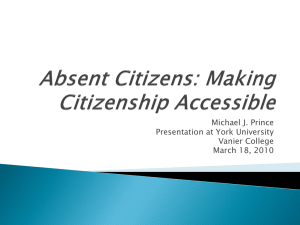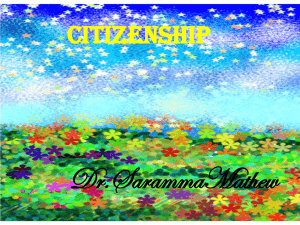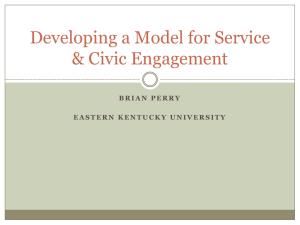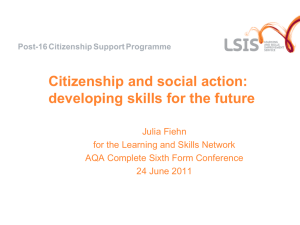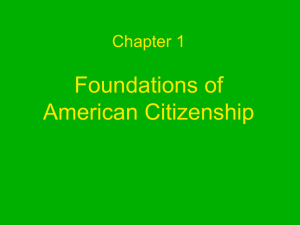File
advertisement
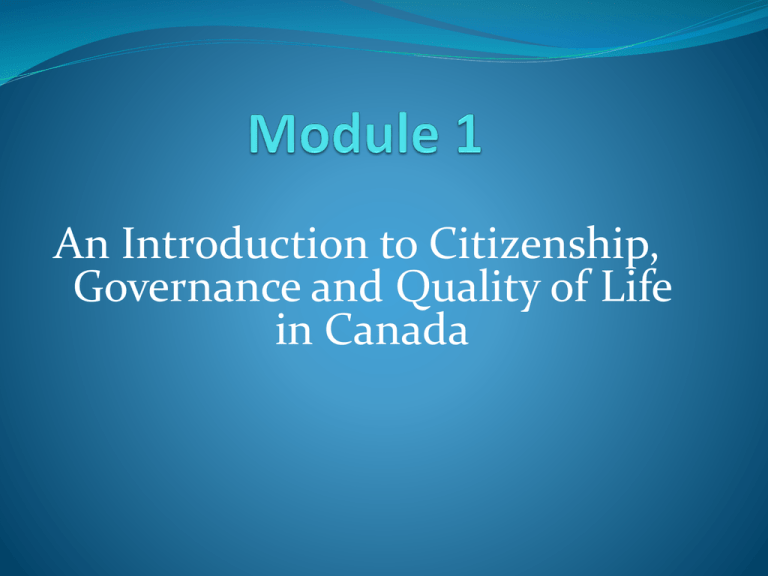
An Introduction to Citizenship, Governance and Quality of Life in Canada Citizenship • What are some understandings of Canadian citizenship? • An understanding of who you are and where you fit into your surroundings. • People identify themselves both as individuals and as part of a group. • This group identity is called a collective identity. Example - Individual identities – Athlete, student, father Collective Identities – Part of a Team, Tofield Titan, the Bobier family • A recognition that a person belongs in a country • Recognition of citizenship confers rights, responsibilities and benefits to a person within society Example - Canadian Citizenship, American Citizenship, European Union Citizenship • Although Canada became an independent nation in 1867, there was no Canadian citizenship before 1947. Canadians were simply British subjects. • This made Canada only the second British Colony to establish its own citizenship after Ireland. Australia would establish its citizenship in 1948. • The 1947 Act did not allow for dual citizenship. Canadians who had ties with other nations had to choose their citizenship • In 1977 the Citizenship Act reformed Canada’s law and allowed for dual and multiple citizenship. The 1977 Act is Canada’s current law although it has been amended since then. In most cases, under the 1977 Citizenship Act you are a Canadian citizen if : • you were born in Canada; • you were born in another country after February 14, 1977, and one of your parents was a Canadian citizen at the time of your birth; • you received citizenship through the process of naturalization. To become a Canadian citizen: • you must be 18 years of age or older; • you must be a permanent resident who has lived in Canada for three of the four years immediately preceding the application; • you must be able to communicate in English or French; and • you must have knowledge of Canada, including the rights and responsibilities of citizenship. Study the two readings on pages 4 &5 of your Module Booklet and complete the reflection questions on page 6. If you finish early, work on the Key Concepts found on page 2. • How Citizenship and Citizenship Laws are defined in Canada • Identify and explain the values and responsibilities of Citizenship. • Describe how examples of active citizenship in action Friday, September 5 Review your reflection on page 6 of your Module Booklet. Complete the summary chart on page 7. You may work with a partner to do this. Quality of Life • What factors are most important for my quality of life? • A measure of personal and collective well-being • Both physical needs and wants and emotional or psychological needs and wants. Example – Food, shelter and protection, but also variety of food choices, a place you feel is home and a sense of safety. Read pages 2-5 of your textbook, “Issues for Canadians” and make a list of factors that you feel are most important to your quality of life. Use page 8 of your Module Booklet. Minimum requirements are twenty factors with a near even mix between physical and psychological or emotional factors. You have twenty minutes. • The process of governing a nation or society. • It includes how citizen’s participate in making decisions, rights and responsibilities and the political system or structure of how decisions are made. Example - Within Canada Governance is provided by three levels of government – Federal, Provincial and Local • Opinions and preferences of an individual based on personal or individual experiences. Example - Some people believe that the justice system is too lenient on serious criminals. Often these people have been the victims of crime. • Values and ideas shared by people with a common language, culture and history. • It can be very difficult to determine perspectives from opinions. Example - First Nations leaders often state that the Canadian justice system discriminates against aboriginals Use the highlighting strategy discussed in class to distinguish between point of view and perspective in the statements on pages 11 and 12 of your Module Booklet. Use the graphic organizer on page 9 of your module booklet to summarize your findings. Complete the questions on page 10. An investigation into he Quality of Life in Canada • Develop a position supported by information gathered during research organize and synthesize researched information • Draw conclusions based upon research and evidence Demonstrate skills of cooperation, conflict resolution and consensus building: • Demonstrate leadership in groups, where appropriate, to achieve consensus and resolve conflicts peacefully and equitably • demonstrate a positive attitude regarding the needs and perspectives of others 1. 2. 3. 4. 5. 6. Set up a workspace for your group Assign Roles – Time keeper, Referee, Presenter Assign Research Topics – 1 each Collect data or evidence Weigh evidence critically Come to Consensus on the claim • Define and identify factors of Quality of Life • Identify common perspectives on QOL (ie. Francophone, First Nation, Recent Immigrant) • Analyze data on QOL Thursday, September 10 Final Module Assignment A caricature is an exaggerated representation of a person, usually drawn in order to bring out the details of a person’s life.


